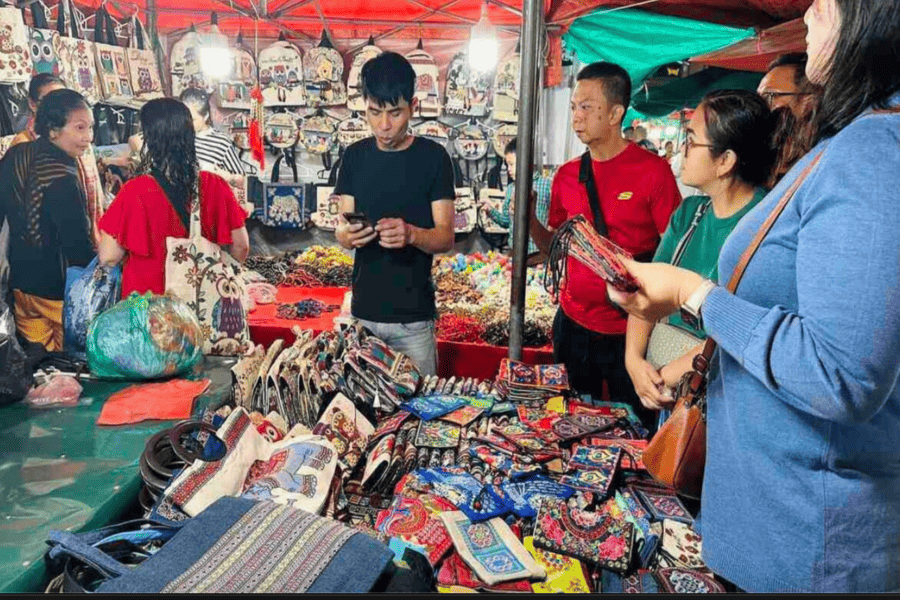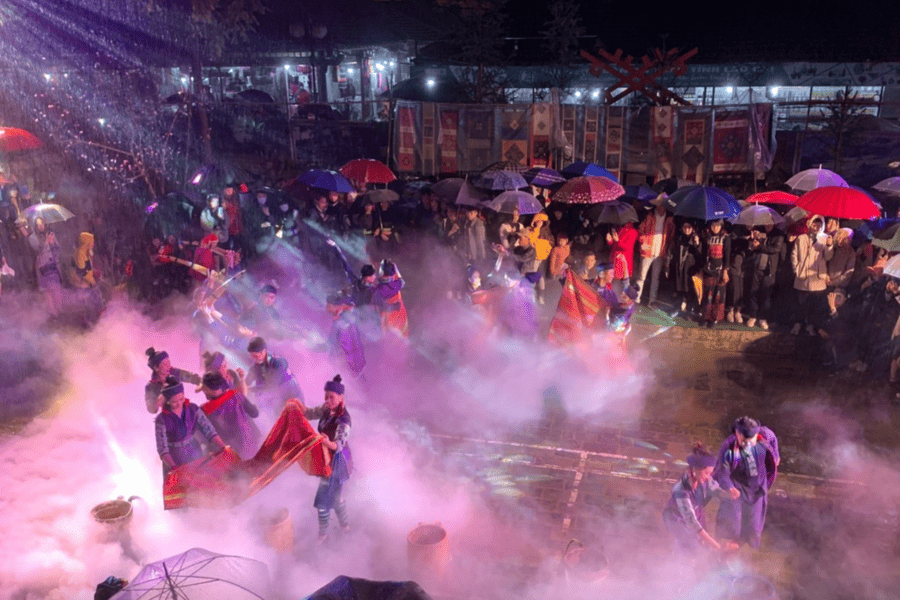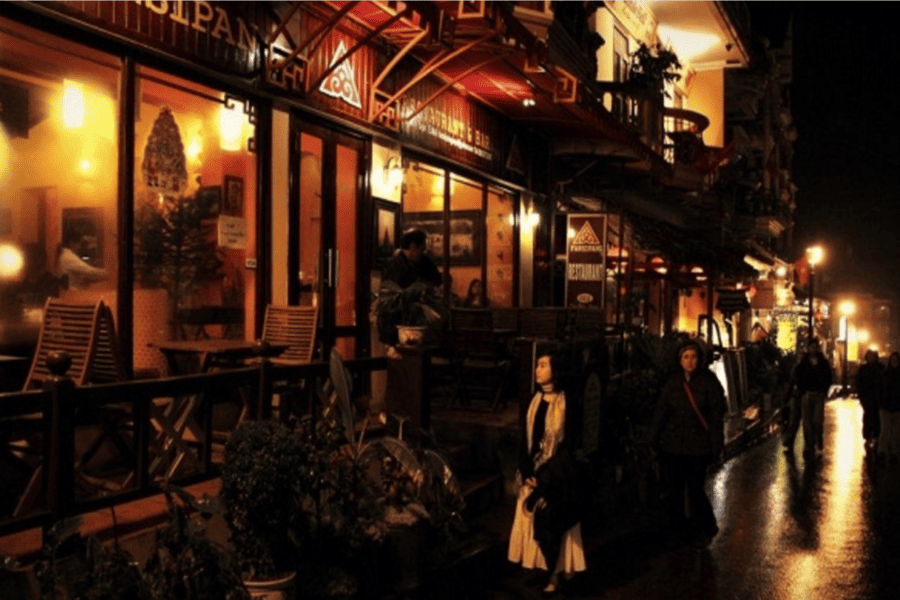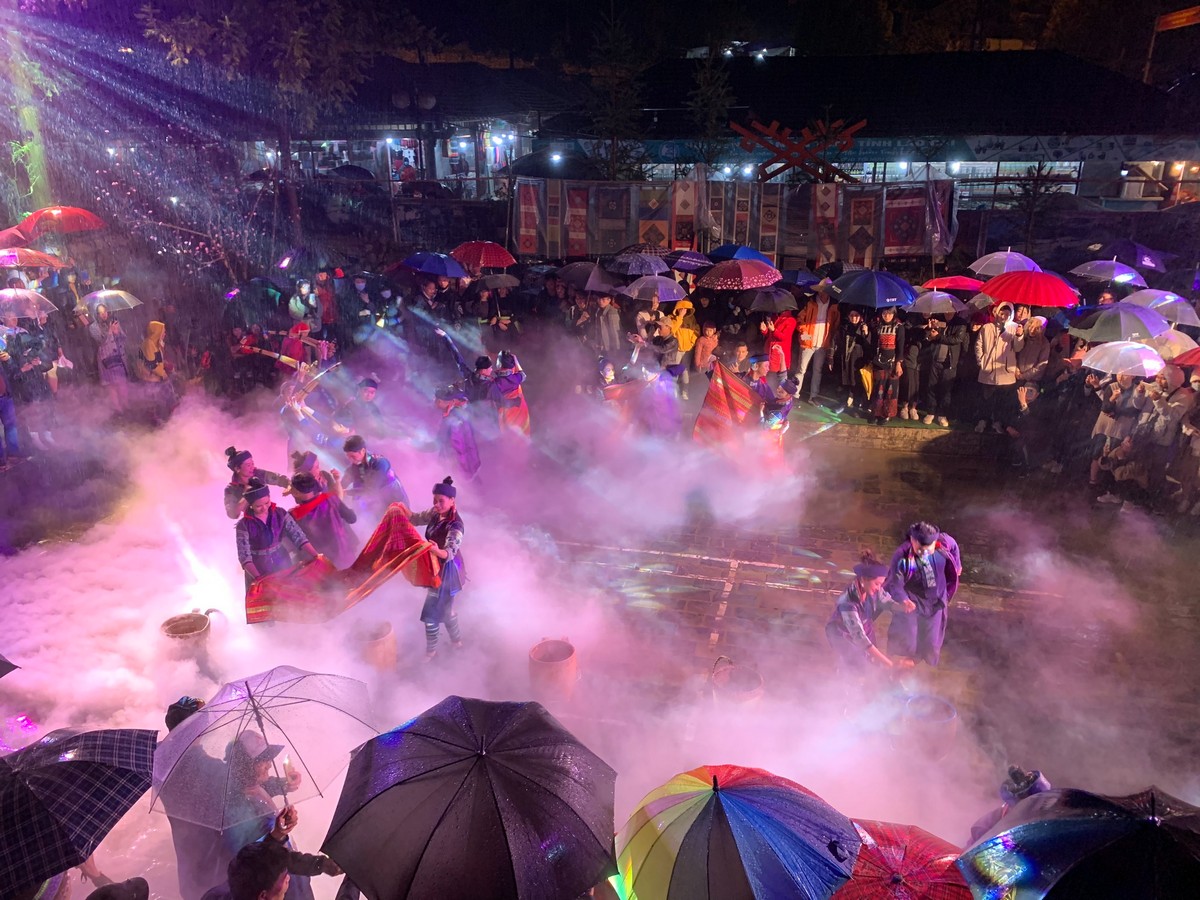Sapa nightlife truly comes alive at the town’s vibrant night market – a must-visit experience for any traveler. Open every evening, this bustling hub is where Sapa’s heart continues to beat after dark. Ethnic minority vendors from nearby villages gather to sell handwoven textiles, silver jewelry, and herbal remedies. More than just a place to shop, the night market offers an authentic glimpse into local life and culture. Explore one of the most memorable highlights of exploring Sapa nightlife in trips to Vietnam and Cambodia.
7 Peaceful Yet Unforgettable Nighttime Experiences
Sapa’s nightlife strikes a perfect balance between lively cultural encounters and serene, reflective moments. Below, we dive into seven must-do experiences that showcase the town’s unique evening vibe.
1. Explore the Buzz of Sapa Night Market

No visit to Sapa is complete without a stroll through its iconic night market. Open every evening, this vibrant hub is where the town’s heart continues to beat after dark. Ethnic minority vendors from nearby villages, such as the H’Mong and Dao, set up colorful stalls to sell handwoven textiles, intricate silver jewelry, and traditional herbal remedies. The market is more than a shopping destination—it’s a cultural immersion. As you wander through the rows of stalls, you’ll be greeted by warm smiles and the chance to learn about the craftsmanship behind each item. Bargaining is part of the experience, so don’t hesitate to engage with vendors for a friendly haggle. The vibrant colors, aromatic street food, and lively chatter make the Sapa Night Market a must-visit for any traveler seeking an authentic glimpse into local life.
2. Feast on Street Food Like a Local
As the sun sets and the mountain air turns crisp, Sapa’s street food scene comes alive. Food stalls pop up around the main square and near the night market, offering a variety of mouthwatering dishes that warm both body and soul. Savor the smoky flavors of thịt nướng (grilled skewers), indulge in cơm lam (sticky rice cooked in bamboo), or snack on roasted chestnuts for a quick bite. For a heartier meal, join locals around steaming hot pots filled with fresh vegetables, meats, and fragrant broths. The affordability of these dishes—often costing just a dollar or two—makes it easy to sample a variety of flavors. Eating at these stalls isn’t just about the food; it’s about joining the communal spirit of Sapa’s evenings, where locals and travelers bond over shared meals and lively conversations.
3. Unwind with Sapa Nightlife at Cozy Cafés and Hidden Bars

While Sapa may not boast the raucous nightlife of big cities, its cozy cafés and hidden bars offer a perfect setting for a relaxed evening. Many cafés, perched on hillsides with stunning views of the valleys below, provide warm blankets, crackling fireplaces, and intimate atmospheres. Sip on a cup of rich Vietnamese coffee, a glass of mulled wine, or even a locally brewed tea infused with mountain herbs. Some venues host acoustic music performances, adding a soft soundtrack to your evening. For those seeking a livelier vibe, Sapa’s hidden bars serve everything from potent rice wine to classic cocktails in rustic settings. Venues like The Hill Station or Sapa Sky Bar offer a blend of local charm and modern comfort, making them ideal spots to unwind after a day of exploration.
4. Enjoy Traditional Ethnic Music and Dance Performances

Sapa’s nightlife is deeply rooted in its cultural heritage, and one of the best ways to experience this is through traditional music and dance performances. Many hotels, cultural centers, and local venues host nightly shows featuring the music and dances of Sapa’s ethnic minority groups, such as the H’Mong, Dao, and Tay. Expect to hear the soulful melodies of bamboo flutes, rhythmic beats of hand drums, and see vibrant dances that tell stories of love, harvest, and mountain life. These performances are not just entertaining—they’re a window into the traditions and beliefs that shape Sapa’s identity. Check with your accommodation or tour operator, such as True Indochina Tours, for schedules and venues hosting these cultural showcases.
5. Stroll Around the Tranquil Sapa Lake
For a quieter, more reflective experience, take an evening walk around Sapa Lake. Nestled in the heart of town, this serene body of water is surrounded by trees and softly lit pathways, creating a peaceful ambiance after dark. The lake reflects the twinkling lights of nearby buildings, adding a touch of magic to the scene. Locals often gather here to chat, snack, or simply enjoy the calm atmosphere. Whether you’re traveling with a partner or seeking a moment of solitude, a stroll around Sapa Lake is a perfect way to soak in the town’s tranquil charm. Bring a light jacket, as the mountain air can get chilly, and let the serenity of the lake wash over you.
6. Try a Night Trek or Stay Overnight in a Local Village
For adventurous travelers, Sapa’s nightlife takes on a whole new dimension with a night trek or a homestay in a nearby ethnic minority village. Guided night treks, led by knowledgeable local guides, take you through moonlit trails surrounded by the sounds of nature—crickets chirping, leaves rustling, and the distant calls of nocturnal creatures. Alternatively, book a homestay in villages like Tả Van or Lao Chải, where you can spend the night in a traditional stilt house. Sharing a meal with a host family, hearing their stories, and waking up to misty rice terraces is an experience that captures the raw beauty of Sapa. These immersive activities, often arranged through operators like True Indochina Tours, offer a deeper connection to the region’s culture and landscapes.
7. Take a Peaceful Walk Under the Stars

Sapa’s clear mountain air and minimal light pollution make it an ideal place for stargazing. On clear nights, venture out to the quieter streets or nearby hills for a walk under a blanket of twinkling stars. The cool breeze, the silence of the mountains, and the vastness of the night sky create a sense of peace that’s hard to find in urban settings. This simple activity is perfect for couples seeking a romantic moment or solo travelers looking to reflect after a day of exploration. For the best experience, head to a spot like Ham Rong Mountain’s lower paths or a quiet road outside the town center, where the stars shine brightest.
Tips for Enjoying Sapa Nightlife
To make the most of your evenings in Sapa, keep these tips in mind:
- Dress Warmly: Sapa’s nights can be chilly, especially in the cooler months (October to March). Layer up with a jacket, scarf, and comfortable shoes for walking.
- Bring Cash: Many night market vendors and street food stalls don’t accept cards, so have small denominations of Vietnamese Dong handy.
- Respect Local Customs: When visiting villages or attending cultural performances, be mindful of local traditions. Ask permission before taking photos of people or their stalls.
- Book Guided Experiences: For night treks, homestays, or cultural shows, working with a reputable tour operator like True Indochina Tours ensures safety and authenticity.
- Check the Weather: Clear nights are best for stargazing or outdoor activities, so plan around the forecast to avoid foggy or rainy evenings.
Navigating Sapa’s Nighttime Transportation
Sapa’s hilly terrain and limited public transport require careful planning to navigate after dark. Whether you’re heading to the night market or a nearby village, understanding your options ensures a smooth and safe evening.
1. Walking Safely in Sapa’s Town Center
Most of Sapa’s nightlife, including the night market and Sapa Lake, is within walking distance of the town center. However, cobblestone streets and uneven paths can be challenging, especially in low light. Wear sturdy, comfortable shoes and carry a small flashlight or use your phone’s light to avoid tripping. Stick to well-lit areas like the main square, and if you’re unsure about directions, ask your hotel or True Indochina Tours for a map or guided walking route to popular spots.
2. Using Motorbike Taxis or Private Cars
For destinations beyond the town center, such as villages like Cat Cat or Tả Van for homestays, motorbike taxis (xe ôm) or private cars are reliable options. Motorbike taxis cost around 50,000–100,000 VND ($2–4 USD) for short trips, while private cars, arranged through hotels or True Indochina Tours, range from 100,000–200,000 VND ($4–8 USD). Always use verified drivers to ensure safety, and confirm the price upfront. For night treks, transportation is typically included in guided tours, simplifying logistics.
3. Planning Return Trips After Dark
Public transport options like buses or shared vans are scarce after sunset, so plan your return trip in advance. If you’re visiting a village or attending a late event, arrange a pickup with your driver or tour operator. True Indochina Tours can coordinate round-trip transportation for evening activities, ensuring you’re not stranded. Carry your accommodation’s address and a local contact number, as phone signals can be weak in rural areas.
Understanding Sapa’s Ethnic Communities at Night
Sapa’s nightlife is deeply enriched by its ethnic minority communities, particularly the H’Mong and Dao, whose traditions shape the evening atmosphere. Learning about their customs enhances your appreciation of the night market and cultural events.
1. The H’Mong’s Role in the Night Market
The H’Mong people are a driving force behind Sapa’s night market, traveling from villages like Lao Chải to sell handwoven textiles and silver jewelry. Their intricate embroidery often features patterns symbolizing family, nature, or spiritual beliefs, reflecting centuries-old craftsmanship. Engaging with H’Mong vendors—by asking about their work or practicing a few polite phrases in Vietnamese—builds meaningful connections. True Indochina Tours offers guided market visits that explain the cultural significance of these crafts, deepening your experience.
2. The Dao’s Herbal Traditions
The Dao community is renowned for its knowledge of herbal remedies, which you’ll find at the night market in the form of teas, balms, and bath blends. These remedies, rooted in traditional medicine, use mountain herbs to promote wellness. For example, Dao vendors may offer dried herbs for soothing teas or pouches for foot soaks. Respect their expertise by inquiring about the uses of their products rather than bargaining aggressively. Some homestays arranged by True Indochina Tours include demonstrations of these herbal practices, offering insight into Dao culture.
3. Respecting Cultural Practices at Night
Interacting with ethnic communities requires sensitivity, especially during evening events like performances or village visits. Always ask permission before photographing vendors or performers, as some may consider it intrusive. Dress modestly, particularly in villages, and avoid loud behavior that could disrupt the serene atmosphere. If invited to a homestay, follow local customs, such as removing shoes before entering. True Indochina Tours can provide guides who explain these etiquette points, ensuring respectful and rewarding interactions.
Best Times for Sapa’s Nightlife Adventures
Timing your visit to Sapa can significantly enhance your nightlife experience, as seasons and cultural events influence the evening offerings. Planning around these factors ensures you catch Sapa at its most vibrant.
1. Dry Season for Clear Nights
The dry season, from October to April, brings cool, clear nights with temperatures of 5–15°C (41–59°F), ideal for outdoor activities like stargazing or night treks. The crisp air and minimal cloud cover make these months perfect for enjoying Sapa Lake’s reflections or the night market’s vibrant stalls. Check weather forecasts before planning outdoor activities, and book guided tours through True Indochina Tours to ensure safe routes and optimal conditions.
2. Wet Season for Indoor Charm
From May to September, Sapa’s wet season brings occasional evening rain, making indoor venues like cozy cafés or cultural performance spaces more appealing. These months offer lush scenery, and venues like The Hill Station provide warm, inviting settings for a relaxed night. If you’re visiting during this period, focus on indoor activities and carry a lightweight raincoat for brief outdoor ventures. True Indochina Tours can recommend weather-appropriate evening itineraries.
3. Festival Seasons for Cultural Highlights
Sapa’s ethnic festivals, such as the H’Mong’s Gau Tao Festival (often in spring) or Tet Nguyen Dan (Lunar New Year, typically January or February), transform the nightlife with bonfires, traditional dances, and communal feasts. These events, often held in villages or the town center, showcase ethnic traditions in a festive atmosphere. Check event schedules with True Indochina Tours to align your visit with these celebrations, ensuring you experience Sapa’s nightlife at its most lively and authentic.


0 Comment